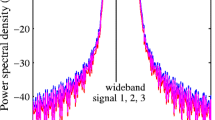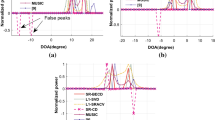Abstract
The performance of traditional physics-driven direction-of-arrival (DOA) methods suffers from array imperfection, coherent signals, and computational complexity. In this paper, the multi-objective joint learning (MOJL) model is proposed to mine the latent joint features of multiple coherent signals and separate them into different subnetworks. The data of each signal are reconstructed and used for super-resolution DOA estimation according to the output of the subnetwork. The simulation results show that the proposed method can separate the data of multiple coherent signals with small errors. The statistical results demonstrate that the performance of the proposed method is superior to the traditional physics-driven methods and state-of-the-art data-driven methods in DOA estimation accuracy, and generalization to signal-to-noise ratio (SNR) and array imperfection.















Similar content being viewed by others
References
Tomic S, Beko M, Dinis R (2017) 3-D Target localization in wireless sensor networks using RSS and AoA measurements. IEEE Trans Veh Technol 66(4):3197–3210
Wan L, Han G, Shu L, Chan S, Zhu T (2016) The application of DOA estimation approach in patient tracking systems with high patient density. IEEE Trans Industr Inform 12(6):2353–2364
Xu J, Wang W-Q, Gui R (2019) Computational efficient DOA, DOD, and Doppler estimation algorithm for MIMO radar. IEEE Signal Processing Letters 26(1):44–48
Huang H, Yang J, Huang H, Song Y, Gui G (2018) Deep learning for super-resolution channel estimation and DOA estimation based massive MIMO system. IEEE Trans Veh Technol 67(9):8549–8560
Yang T, Zheng J, Su T, Liu H (2021) Fast and robust super-resolution DOA estimation for UAV swarms. Signal Processing 188:108187
Schmidt R (1986) Multiple emitter location and signal parameter estimation. IEEE Trans Antennas Propag 34(3):276–280
Roy R, Kailath T (1989) ESPRIT-Estimation of signal parameters via rotational invariance techniques. IEEE Trans Acoust Speech Signal Process 37(7):984–995
Ziskind I, Wax M (1988) Maximum likelihood localization of multiple sources by alternating projection. IEEE Trans Acoust Speech Signal Process 36(10):1553–1560
Wu X, Zhu W -P, Yan J (2016) Direction of arrival estimation for off-grid signals based on sparse Bayesian learning. IEEE Sensors J 16(7):2004–2016
Sedighi S, Mysore BS, Soltanalian RM, Ottersten B (2021) On the performance of one-Bit DoA estimation via sparse linear arrays. IEEE Trans Signal Process 69:6165–6182
Xiang H, Chen B, Yang M, Li C (2019) Altitude measurement based on characteristics reversal by deep neural network for VHF radar, IET Radar. Sonar & Navigation 13(1):98–103. [Online]. Available: https://doi.org/10.1049/iet-rsn.2018.5121
Wu L-L, Huang Z-T (2019) Coherent SVR learning for wideband direction-of-arrival estimation. IEEE Signal Processing Letters 26(4):642–646
Liu Z-M, Zhang C, Yu PS (2018) Direction-of-arrival estimation based on deep neural networks with robustness to array imperfections. IEEE Trans Antennas Propag 66(12):7315–7327
Xiang H, Chen B, Yang M, Yang T, Liu D (2019) A novel phase enhancement method for low-angle estimation based on supervised dnn learning. IEEE Access 7:82329–82336
Xiang H, Chen B, Yang M, Xu s., Li Z (2021) Improved direction-of-arrival estimation method based on LSTM neural networks with robustness to array imperfections. Appl Intell 51(7):4420–4433
Yang Y, Gao F, Qian C, Liao G (2020) Model-aided deep neural network for source number detection. IEEE Signal Processing Letters 27:91–95
Huang H, Yang J, Huang H, Song Y, Gui G (2018) Deep learning for super-resolution channel estimation and DOA estimation based massive MIMO system. IEEE Trans Veh Technol 67(9):8549–8560
Elbir AM (2020) deepMUSIC: Multiple signal classification via deep learning. IEEE Sensors Letters 4(4):1–4
Xiang H, Chen B, Yang T, Liu D (2020) Phase enhancement model based on supervised convolutional neural network for coherent doa estimation. Appl Intell 50:2411–2422
Xiang H, Chen B, Xu S, Li Z (2021) Improved direction-of-arrival estimation method based on lstm neural networks with robustness to array imperfections. Appl Intell 51:4420–4433
Wang J, Jiang C, Zhang H, Ren Y, Chen KC, Hanzo L (2019) Thirty years of machine learning: The road to pareto-optimal wireless networks. IEEE Communications Surveys and Tutorials
Akter R, Doan V-S, Huynh-The T, Kim D-S (2021) RFDOA-Net: An efficient convNet for RF-based DOA estimation in UAV surveillance systems. IEEE Trans Veh Technol 70(11):12209–12214
Hu C, He S, Wang Y (2021) A classification method to detect faults in a rotating machinery based on kernelled support tensor machine and multilinear principal component analysis. Appl Intell 51:2609–2621
Hu C, Wang Y, Gu J (2020) Cross-domain intelligent fault classification of bearings based on tensor-aligned invariant subspace learning and two-dimensional convolutional neural networks. Knowledge-Based Systems, (209): 106214
Wan L, Sun Y, Sun L, Ning Z, Rodrigues JJPC (2021) Deep learning based autonomous vehicle super resolution DOA estimation for safety driving. IEEE Trans Intell Trans Syst 22(7):4301–4315
Agatonović M, Stanković Z, Milovanović B, Donč ov N (2011) DOA estimation using radial basis function neural networks as uniform circular antenna array signal processor. In: 2011 10th international conference on telecommunication in modern satellite cable and broadcasting services (TELSIKS), vol 2, pp 544–547
Ziskind I, Wax M (1988) Maximum likelihood localization of multiple sources by alternating projection. IEEE Trans Acoust Speech Signal Process 36(10):1553–1560
Shan T, Wax M, Kailath T (1985) On spatial smoothing for direction-of-arrival estimation of coherent signals. IEEE Trans Acoust Speech Signal Process 33(4):806–811
Randazzo A, Abou-Khousa MA, Pastorino M, Zoughi R (2007) Direction of arrival estimation based on support vector regression: experimental validation and comparison with MUSIC. IEEE Antennas Wirel Propag Lett 6:379–382
El Zooghby A, Christodoulou C, Georgiopoulos M (2000) A neural network-based smart antenna for multiple source tracking. IEEE Trans Antennas Propag 48(5):768–776
Kingma DP, Ba J (2015) Adam: A method for stochastic optimization. In: Proc of the 3rd international conference for learning representations (ICLR)
Acknowledgements
This work was supported in part by the fundamental Research Funds for the Central University, and the National Natural Science Foundation of China under Grant on 61971323 and 61771180. The authors sincerely express their gratitude to anonymous reviewers and editor for their helpful and constructive comments and suggestions.
Author information
Authors and Affiliations
Corresponding author
Ethics declarations
Conflict of Interests
The authors declared that they have no conflicts of interest.
Additional information
Publisher’s note
Springer Nature remains neutral with regard to jurisdictional claims in published maps and institutional affiliations.
Rights and permissions
About this article
Cite this article
Xiang, H., Qi, M., Chen, B. et al. Signal separation and super-resolution DOA estimation based on multi-objective joint learning. Appl Intell 53, 14565–14578 (2023). https://doi.org/10.1007/s10489-022-03694-y
Accepted:
Published:
Issue Date:
DOI: https://doi.org/10.1007/s10489-022-03694-y




